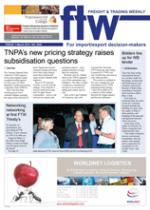The rail service offered
by Transnet Freight
Rail on the busy Natcor
corridor between Gauteng
and Durban over the past
year has generally been
of a high standard, says
Christine Pater, general
manager of Bridge
Intermodal, a division
of the Bridge Shipping
Group.
Rail is integral to
Bridge’s intermodal
service offering, and
Pater believes that
the company’s value
proposition is enhanced
by its full supply chain
capability encompassing
warehousing, rail and
road transport.
“We have two private
sidings at our City Deep
facilities, which are an
added benefit, and Bridge
Intermodal Durban has
the use of a rail siding
situated in its facilities
in Bayhead which is able
to receive bulk cargo and
dispatch export containers
to the Port for export
shipment.
“The export containers
which are loaded onto
this siding are moved via
a shuttle service directly
into DCT/Pier 1 for
placing into the vessel’s
stacks.”
The ability to utilise
the shuttle service means
that a volume throughput
of containers can be
moved at any given stage,
reducing congestion in the
depot, she added.
And while there are
constraints on rail, Pater
believes the same applies
to road transport. “Rates
are driven by marketshare
and availability of
vehicles at a cost-effective
rate. The difference
between rail and road is
that volume can be moved
by rail while road is on
a per-vehicle basis and is
subject to availability, she
said.
“Over the past year,
with the exception
of a few unavoidable
deviations caused, for
example, by inclement
weather conditions, the
Bridge Shipping Group
has railed large volumes
of traffic, said Pater.
“Our outlook for
this year is to continue
increasing rail capacity
– but this is largely
dependent on the
imminent increase in rail
rates.
“Growing marketshare
and increasing road
transport opportunities
locally within our Durban
division is the focus for
2013,” she said.
INSERT
‘Rail growth depends
on impact of imminent
increase in rail rates.’

